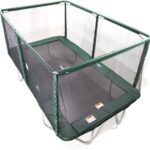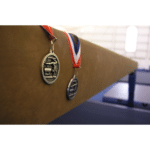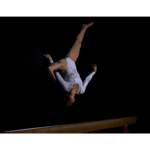
Are you tired of dealing with painful gymnastics rips on your hands from training? Look no further – this article offers a comprehensive approach to preventing and recovering from these common injuries. With tips and strategies for prevention and recovery, you can say goodbye to the frustration and discomfort of hand rips.
Disclaimer: This article is intended as generic advice based on my experience as a gymnastics coach. It does not replace the need for professional medical advice.
Table of Contents
- Key Takeaways:
- What Are Gymnastics Rips?
- Rip Prevention
- Use of Grips or Tape
- The Effects of Gymnastics Rips
- How To Treat Rips
- Conclusion
- FAQs about Gymnastics Rips
- What are gymnastics rips and how can they be prevented?
- What should I do if I get a rip on my hands from gymnastics?
- Can I still perform with a rip on my hands?
- Are there any tips for faster healing of rips?
- How can I treat torn calluses on my hands from gymnastics?
- Is it normal for gymnasts to have calluses?
Key Takeaways:
- Proper hand care and grip technique can prevent hand rips and callus build-up.
- Rips are common and hard to avoid at a competitive level.
- Recovery from hand rips should build up resistance to further rips.
What Are Gymnastics Rips?
Gymnastics rips are a common type of injury that gymnasts often encounter, especially those who frequently work on bars and rings. They occur when the skin on the palms of the hands becomes torn or blistered due to friction against the apparatus.
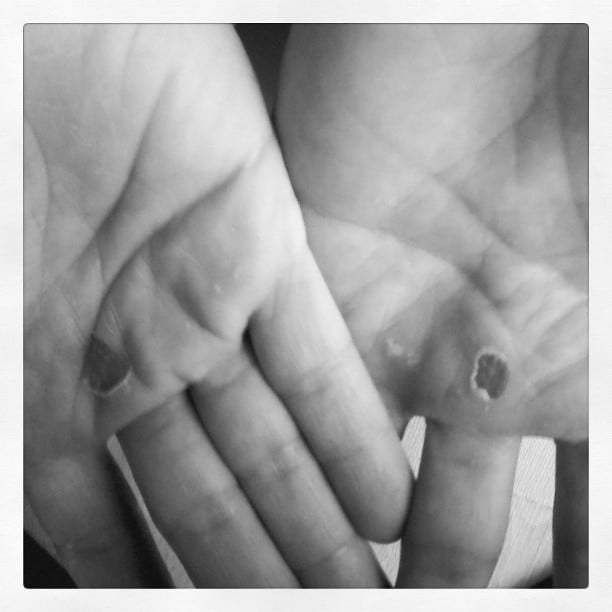
Rips become more common when gymnasts learn to swing as this increases the movement of the hands around the apparatus. Over time, this can cause the upper layers of skin to separate and form blisters or to tear away completely.
- Appearance: Rips typically look like a flap of skin that has been torn away. The area is usually red, raw, and quite tender.
- Location: They most commonly occur on the palm of the hand, particularly around the areas where the fingers meet the palm.
Rip Prevention
Unfortunately, rips cannot be completely prevented. All gymnasts who begin to work at a competitive level will start to get rips because of the nature of the skills and the apparatus. At a beginner level, they are less common as the skills require less movement around the apparatus.
Although rips are an accepted part of training for many gymnasts, they can be reduced and should be treated effectively so that performance is not hampered too much. Read on for the best ways to avoid rips as much as possible.
- Keep hands soft: Avoid excessive callus build-up by moisturizing hands regularly and washing hands with soap after practice.
- Proper grip technique: Place the bar directly at the base of your fingers to reduce friction and prevent rips.
- Use gymnastics grips: Invest in high-quality grips to protect your hands.
- Gradual conditioning: Start with less intense training to gradually toughen and the skin.
- Healthy rips: Allow calluses to form naturally for protection against rips and to maintain healthy skin.
- Proper nutrition: Consume foods rich in vitamins C and E.
Fact: Prioritizing soft hands and mastering proper grip technique significantly reduces hand rips and enhances performance.

The Ript System is ideal for gymnasts as it both protects and heals the hands. The kit above has 3 parts:
- Salve which repairs damaged skin and protects open wounds from infection.
- Moisturizing hand balm made from natural ingredients to keep the hands hydrated.
- Grindstone to smooth out rough Calluses.
What we like about Ript are the natural ingredients that are safe for children to use and it’s excellent value for money. The 3 part kit usually sells for around $20.
Use of Grips or Tape
When trying to prevent rips on the hands from gymnastics, using grips or tape is crucial. Gymnastics tape for rips protects the hands. Grips are also important as they act as a barrier between the hands and the bar, reducing friction and the likelihood of rips.

When utilizing protective gear such as grips or tape, gymnasts can prevent unnecessary rips and continue training effectively.
Pro-tip: Make sure to properly size and apply grips or tape for rips to maximize their effectiveness and minimize discomfort on the bar.

The Effects of Gymnastics Rips
When rips do occur they cause a lot of discomfort.
Pain and Tenderness
Hand rips in gymnastics can cause intense pain and tenderness, especially if they develop into open wounds. Proper care of hand rips is crucial to prevent infection and promote quick recovery. Use antiseptic ointments and sterile dressings to protect open wounds from contamination, and avoid activities that exacerbate pain and discomfort. Consult a healthcare professional for severe hand rips to ensure proper treatment.
Redness and Swelling
Redness and swelling are common symptoms of hand rips in gymnastics. These symptoms occur due to the tearing of the outermost layer of the skin, leading to inflammation and dry skin. It is essential to address redness and swelling promptly to prevent infection and promote faster healing.
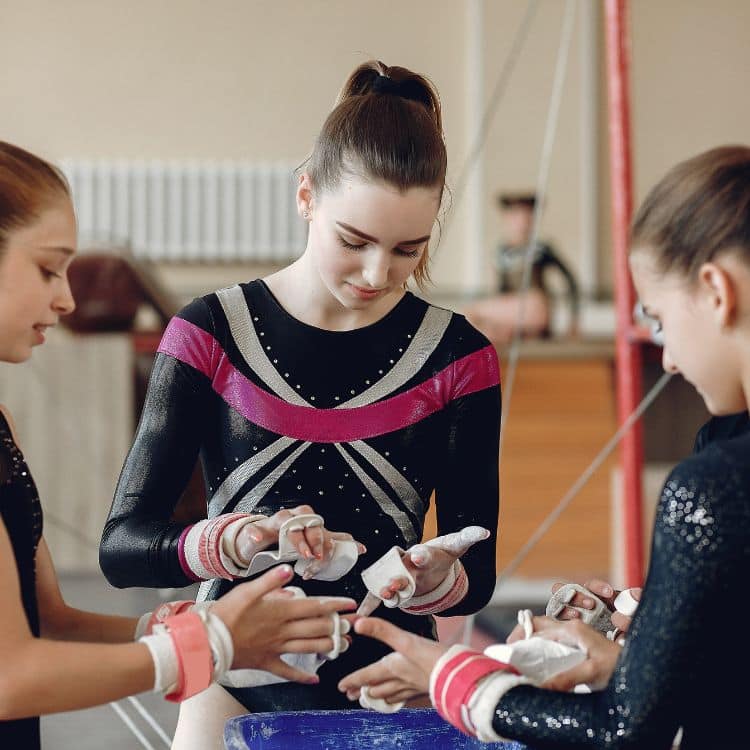
Blistering and Tearing of Skin
- To prevent blistering and tearing, it is important to keep the skin clean and dry.
- Manage callus build-up by using a pumice stone or callus remover.
- Regularly moisturize the hands to prevent dry skin and improve skin elasticity.
Pro-tip: Before training, apply a thin layer of medical tape over sensitive areas to reduce friction and protect against dry skin.
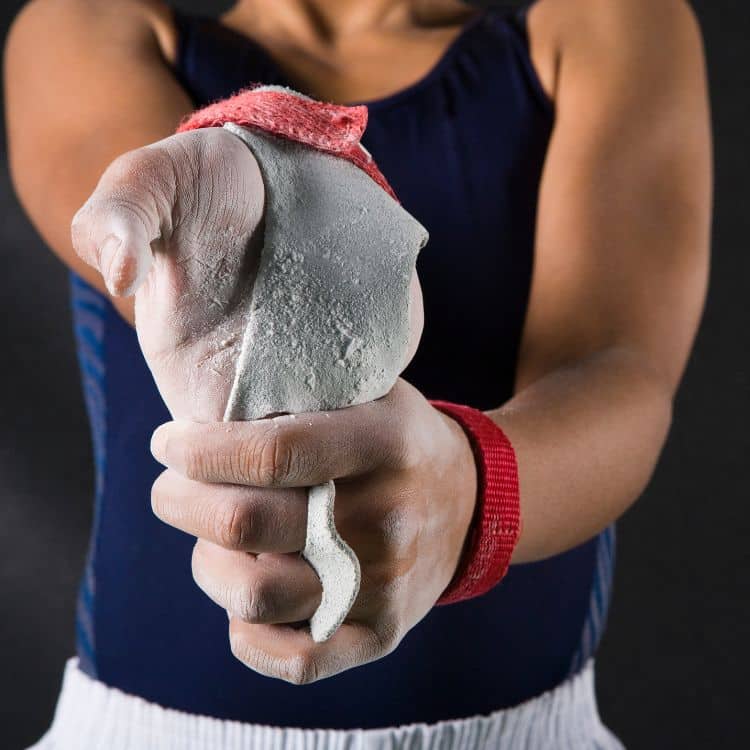
How To Treat Rips
Gymnastics rips are commonly treated by coaches in the gym using the following steps. These steps should be regarded as generic advice and if in doubt always consult a qualified medical professional.
Clean and Disinfect the Wound
- First, gently clean the open wound with mild soap and water to remove dirt and debris.
- Rinse the wound thoroughly to ensure all contaminants are removed.
- Pat the wound dry with a clean cloth or sterile gauze.
- If there is any excess skin, use sterile scissors to remove it.
- Apply a thin layer of antibiotic ointment to prevent infection and promote healing.
- Cover the wound with a sterile bandage to protect it from further contamination.
Pro-tip: Seek medical advice if the wound shows signs of infection and ensure healthy skin regeneration by keeping the area clean and dry.
Rest and Protect the Hand
Once a rip has occurred it’s vital to allow the new layer of skin to grow. To speed up the healing process, keep the hand flat or the new skin will crack once the hand opens up. Try to keep the hand moisturized as well.
The positive thing to remember is that the new layer of skin will often be harder and tougher than it previously was.
- Rest the hand: Avoid activities that strain the hand, specifically bar workouts, to permit healing.
- Protect the hand: Use protective gear like hand grips or tape to shield the affected area during workouts.
Use of Topical Ointments or Creams
When treating ripped calluses or dry skin in gymnastics, topical ointments and creams can provide relief and aid in the healing process. Look for products containing ingredients like vitamin E, aloe vera, or lanolin, as these can help soothe and moisturize the affected skin. Additionally, choose ointments with antiseptic properties to prevent infection and promote faster recovery.
Always consult a professional for individual advice.
Gradual Return to Gymnastics Activities
- Consult a healthcare professional to assess the healing progress.
- Start with light exercises to rebuild healthy skin.
- Gradually introduce low-impact bar workouts to regain hand strength.
- Monitor the skin’s response and adjust intensity accordingly.
- As the hands heal, incrementally incorporate higher impact activities.
Conclusion
Rips are an inevitable part of gymnastics life but with the correct care and management, a gymnast should be able to reduce the number of rips they get. It’s also important to allow the healing process to happen fully so that a gymnast returns stronger and ready to perform at their best.
- A Complete Guide to Gymnastics RipsAre you tired of dealing with painful gymnastics rips on your hands from training? Look no further – this article offers a comprehensive approach to… Read more: A Complete Guide to Gymnastics Rips
- The 12 Types of Trampoline (explained)Trampolines, a staple of joy and fitness, cater to all ages, inspiring kids and adults alike to leap out of their indoor routines into a… Read more: The 12 Types of Trampoline (explained)
- How is Gymnastics Scored? (answered)In the world of gymnastics, every flip, spin, and leap is a blend of athleticism, precision, and artistry. But how is gymnastics scored accurately and… Read more: How is Gymnastics Scored? (answered)
- Level 5 Gymnastics Skills (Guide)This guide delves deep into the Level 5 gymnastics skills, providing insights, breakdowns, and an expert perspective on each skill and its significance in a… Read more: Level 5 Gymnastics Skills (Guide)
- Level 4 Gymnastics Skills (Guide)In this comprehensive guide, we’ll delve into the details of the Level 4 gymnastics skills, breaking down each requirement for a clear understanding. Whether you’re… Read more: Level 4 Gymnastics Skills (Guide)
- Level 3 Gymnastics SkillsLevel 3 is defined as a development level by USAG meaning not all clubs or gymnasts will compete these skills at a competition. This article… Read more: Level 3 Gymnastics Skills
FAQs about Gymnastics Rips
What are gymnastics rips and how can they be prevented?
Gymnastics rips are when the skin gets ripped or torn off the hands or wrists while performing on bars. To prevent rips, it is important to keep calluses shaped and smoothed with products like RIPT Skin Systems’ Grindstone, as well as moisturizing with their Daily Dose hand balm.
What should I do if I get a rip on my hands from gymnastics?
The first step is to clean the wound and remove any excess skin. Then, apply a skin-repairing balm like RIPT’s Quick Fix to promote healing. It is important to constantly reapply the balm to prevent the new layer of skin from drying out.
Can I still perform with a rip on my hands?
It is not recommended to continue performing with a rip on your hands, as it can worsen the injury and make it harder for the skin to heal. It is best to take some time off to allow your hands to heal properly.
Are there any tips for faster healing of rips?
According to Devin Glage from RIPT Skin Systems, the key to faster healing is to prevent the new layer of skin from cracking or ripping again. Constantly reapplying a skin balm, like Quick Fix, can help with this.
How can I treat torn calluses on my hands from gymnastics?
It is important to keep the area clean to treat torn calluses and apply a skin balm like Quick Fix to promote healing. It is also important to reshape and smooth the calluses to prevent further rips from occurring.
Is it normal for gymnasts to have calluses?
Yes, calluses are a natural result of the repeated friction and rubbing on the hands from performing on bars. However, it is important to maintain them properly to prevent rips from occurring.



